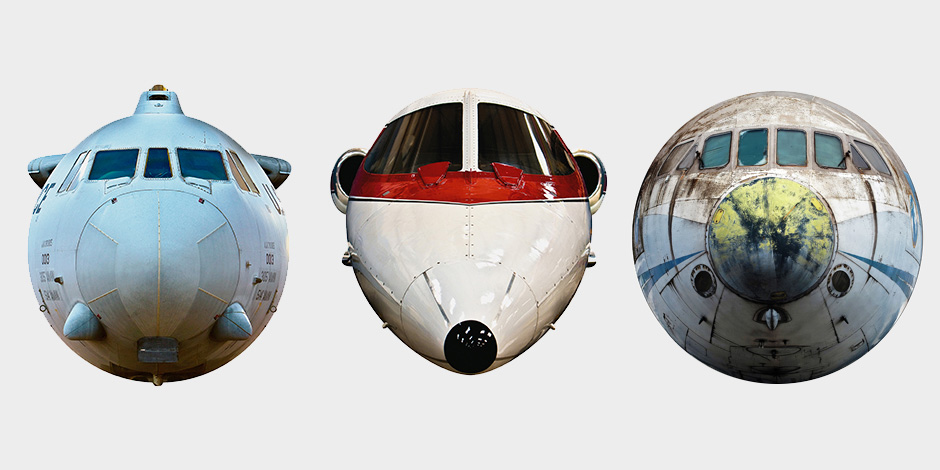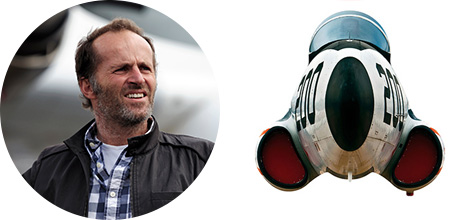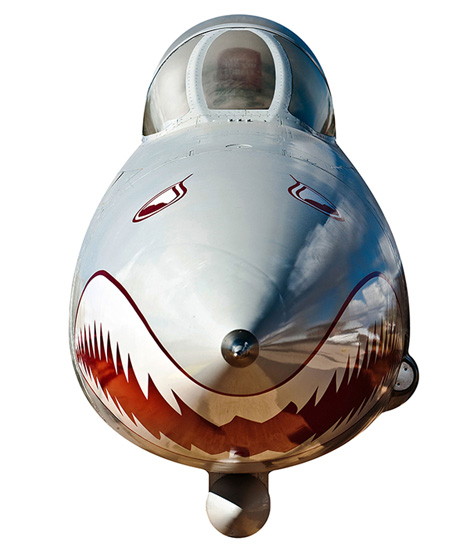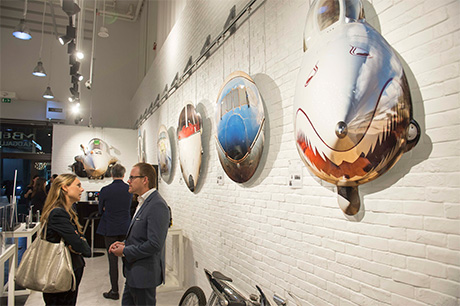
MANOLO CHRÉTIEN
The MB&F M.A.D.Gallery takes flight with French photographer Manolo Chrétien and his powerful aeronautical artwork.
Born in 1966 and raised near Orange Air Force Base in France, Manolo Chrétien has vivid childhood memories of gazing out his bedroom window in awe of the aircrafts soaring through the sky. As the son of Jean-Loup Chrétien, a test pilot and the first French astronaut, hangars filled with prototype jet planes were his playground. He developed his passion for aviation early on in his life, though this was not expressed publicly until later.
“I was inspired by the powerful aesthetic imagery of the planes, the passion and risk involved, and the developing technology. I think there is a strong link between air and art. My father is an artist; his very first dream was to trace the skies with pure curves, creating instant drawings or paintings with a ‘bird pen.’ The purity of line and movement is as important in the air as it is in art.”

Chrétien’s university education began in the south of France studying aeronautical engineering, though he dropped out after a quick three months to pursue his love of windsurfing. Deciding to continue his studies in Paris at the prestigious Olivier de Serres School of Applied Arts, Chrétien discovered a passion and talent for materials and graphic design. He established a sport-centric graphic design business in Paris in 1991 before eventually moving to Rouen, France.
In tandem with his graphic design work, Chrétien rediscovered the fervour for painting and photography originally ignited by his father and grandmother. “My grandma was an excellent photographer and she showed me at a very young age how to use a Minox camera, starting with taking pictures of old fishing boats on the Brittany coast.”
Currently, Chrétien and the love of his life, Céline, run a successful graphic design business and create captivating artwork from a sun-drenched studio in Blois, a picturesque city overlooking the Loire River. Chrétien’s impressive artwork is represented across the globe in galleries from Paris and Montreal to Singapore and London.
nose art
Acclaimed artist and photographer Manolo Chrétien unearths his deeply rooted passion for aviation in the Nose Art exhibition at the MB&F M.A.D.Gallery.


In a powerful yet playful approach, Chrétien captures the essence of famed aircraft nose-to-face as it were. From a luxe 1960s Learjet to the supersonic Concorde jetliner and military vessels like the Dassault Rafale, his images offer a dynamic and unusual dead-on visual perspective. This is further accentuated by the circular cut-out format, which follows the shape of the aircraft’s fuselage.
“Nose Art is the natural outcome of ten years’ worth of trying to capture planes from a humanistic or animalistic angle”
“Nose Art is the natural outcome of ten years’ worth of trying to capture planes from a humanistic or animalistic angle, and it is the beginning of a new way of working,” explains Chrétien. “It's been in my head for years, since my father woke me up one morning from the air through the window of my second floor bedroom in a helicopter he was testing. I remember it as if it were yesterday: the animal-like cockpit of the Alouette, my father with his Ray Bans smiling inside, motioning to say, ‘Time to get out of bed, kids!’”
Each plane has a story to tell, whether this is expressed through corrosion or damage from war: their skin defects reveal the aircraft’s souls. Chrétien, for example, was drawn to the extensively rusted model of the Caravelle due to its impressive political history. The Caravelle De Gaulle (flown by French President Général De Gaulle for years) is also known as a kind of « Vintage French Air Force One » and was referred to by De Gaulle as the “quiet, sweet and silent Caravelle.”
The seven photographs in the Nose Art exhibition endow each aircraft with a humanistic personality, as if the faces of the planes were happily smiling or cautiously glaring. Endless interpretations are left to the observer’s imagination.
PROCESS
Chrétien’s childhood abounded with aeronautical adventures, so it's not surprising that these influential experiences materialize in his compositions.
“My inspiration for Nose Art came suddenly while on a photo trip in the Tucson desert in 2008. I was photographing all sorts of planes when I had a flashback of my brothers and I when we were very young in the garden of our house in Orange, France – right next to the runway, where we were fascinated by the planes taking off.” Chrétien shares. “Growing up I saw the tarmac, kerosene, and aluminium through the eyes of a small child; I was overwhelmed by the size of these huge metal birds flying over me. I photograph from this viewpoint today, sometimes by lying on the ground to recreate a child-like sense of scale. Since my very first photographs I've been fascinated with the textures and colours of used metals, revealing the past and the story of these materials. So scale, colours, and surface textures are very important.”

“To face the Concorde was one of my best moments”
Chrétien generally carries two types of cameras on his photographic journeys: a Canon EOS 5Ds R and a Hasselblad H4D-60. When shooting the planes in preparation for the Nose Art exhibit, it was not an easy task to photograph their noses high up off the ground. Therefore, a trusty tripod and a forklift were essential to boost Chrétien face-to-face with the nose of the plane, creating the best possible angle to photograph these legendary flying machines.
“To face the Concorde was one of my best moments,” Chrétien excitedly describes as if he were reliving the moment. “This amazing plane is a legend and when you go up to the beak of this fantastic metal bird, it’s high and very impressive to realize just how fluid the design of that machine inspired in 1960 by a Northern Gannet bird is!” Chrétien’s photograph easily allows you to imagine the nose of the Concorde piercing the atmosphere at supersonic speeds.
Chrétien combines his artistic talents and imagination with his aeronautical experiences, turning famed aircrafts into emotionally powerful art – art that will provoke a second, third, and fourth look.

